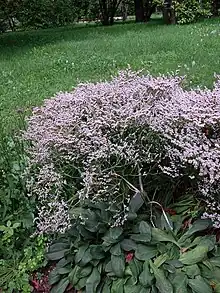| Goniolimon | |
|---|---|
 | |
| Goniolimon tataricum | |
| Scientific classification | |
| Kingdom: | Plantae |
| Clade: | Tracheophytes |
| Clade: | Angiosperms |
| Clade: | Eudicots |
| Order: | Caryophyllales |
| Family: | Plumbaginaceae |
| Genus: | Goniolimon Boiss.[1] |
| Species | |
|
See text | |
| Synonyms | |
| |
Goniolimon, sometimes called the statices, are a genus of flowering plants in the leadwort and plumbago family Plumbaginaceae, native to northern Africa, southern Europe, western and central Asia, Siberia, Mongolia and China.[2] Low-lying perennial shrubs, some species are cultivated as ground covers.[3]
Species
Currently accepted species include:[4]
- Goniolimon africanum Buzurovic, Bogdanovic & Brullo
- Goniolimon besserianum (Schult. ex Rchb.) Kusn.
- Goniolimon callicomum (C.A.Mey.) Boiss.
- Goniolimon caucasicum Klokov
- Goniolimon dalmaticum (C.Presl) Rchb.
- Goniolimon dshungaricum (Regel) O.Fedtsch. & B.Fedtsch.
- Goniolimon elatum (Fisch. ex Spreng.) Boiss.
- Goniolimon eximium (Schrenk) Boiss.
- Goniolimon glaberrimum (Aiton) Klokov
- Goniolimon gorczakovskyi Knjaz.
- Goniolimon graminifolium (Aiton) Boiss.
- Goniolimon heldreichii Halácsy
- Goniolimon incanum (L.) Hepper
- Goniolimon italicum Tammaro, Pignatti & Frizzi
- Goniolimon krylovii A.V.Grebenjuk
- Goniolimon orthocladum Rupr.
- Goniolimon rubellum (S.G.Gmel.) Klokov
- Goniolimon sartorii Boiss.
- Goniolimon sewerzowii Herder
- Goniolimon speciosum (L.) Boiss.
- Goniolimon tataricum (L.) Boiss.
Former species; Goniolimon salicorniaceum (F.Muell.) Christenh. & Byng now called Muellerolimon salicorniaceum (F. Muell.) Lincz.[2]
References
- ↑ A.P.de Candolle, Prodr. 12: 632 (1848)
- 1 2 Koutroumpa, Konstantina; Theodoridis, Spyros; Warren, Ben H.; Jiménez, Ares; Celep, Ferhat; Doğan, Musa; Romeiras, Maria M.; Santos-Guerra, Arnoldo; Fernández-Palacios, Jóse María; Caujapé-Castells, Juli; Moura, Mónica; Menezes De Sequeira, Miguel; Conti, Elena (2018). "An expanded molecular phylogeny of Plumbaginaceae, with emphasis on Limonium (Sea lavenders): Taxonomic implications and biogeographic considerations". Ecology and Evolution. 8 (24): 12397–12424. Bibcode:2018EcoEv...812397K. doi:10.1002/ece3.4553. PMC 6308857. PMID 30619554.
- ↑ Kubitzki, Klaus; Rohwer, Jens G.; Bittrich, Volker (29 June 2013). Flowering Plants: Dicotyledons: Magnoliid, Hamamelid and Caryophyllid Families. Springer. p. 529. ISBN 9783662028995.
- ↑ "Goniolimon". Plants of the World Online. Royal Botanic Gardens, Kew. Retrieved 25 June 2020.
This article is issued from Wikipedia. The text is licensed under Creative Commons - Attribution - Sharealike. Additional terms may apply for the media files.